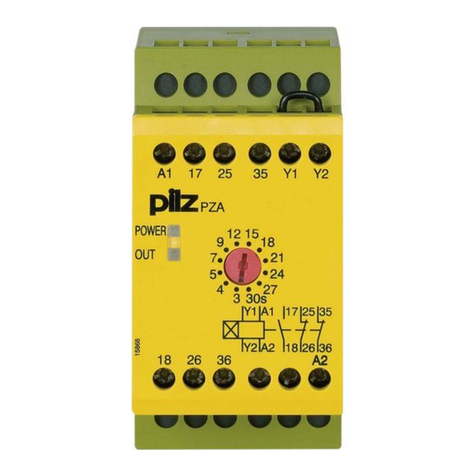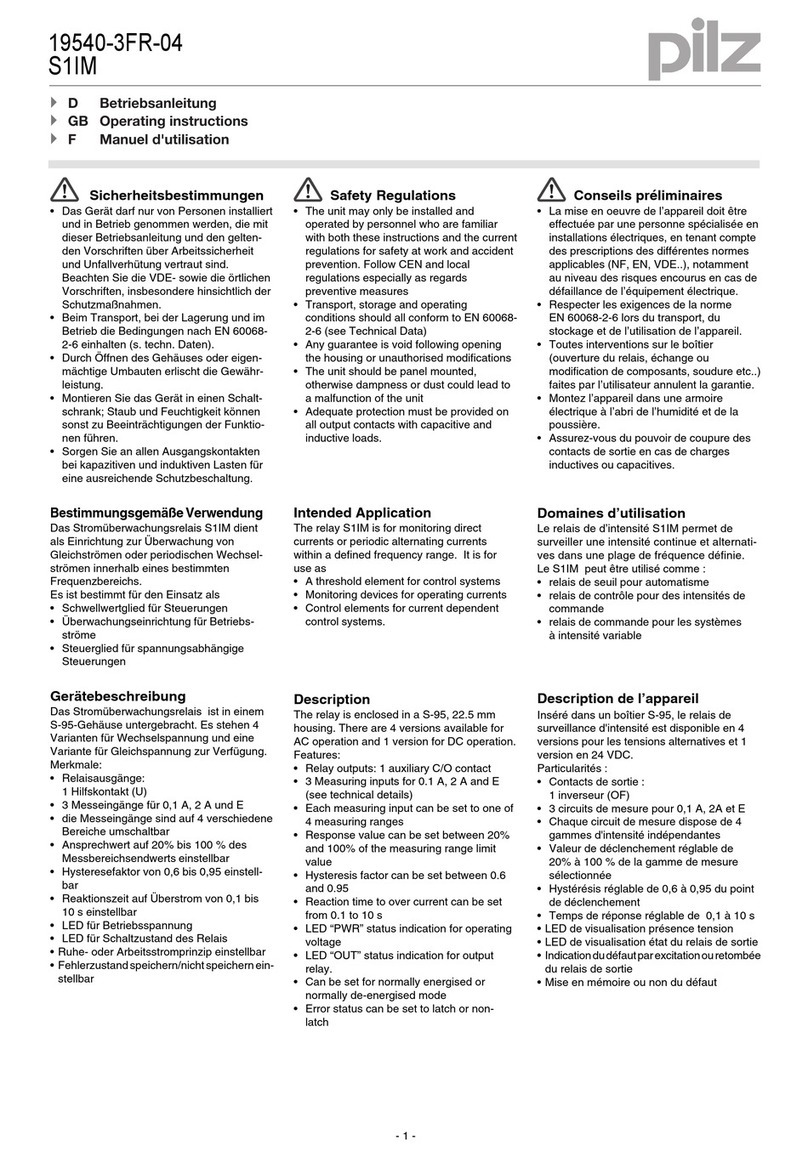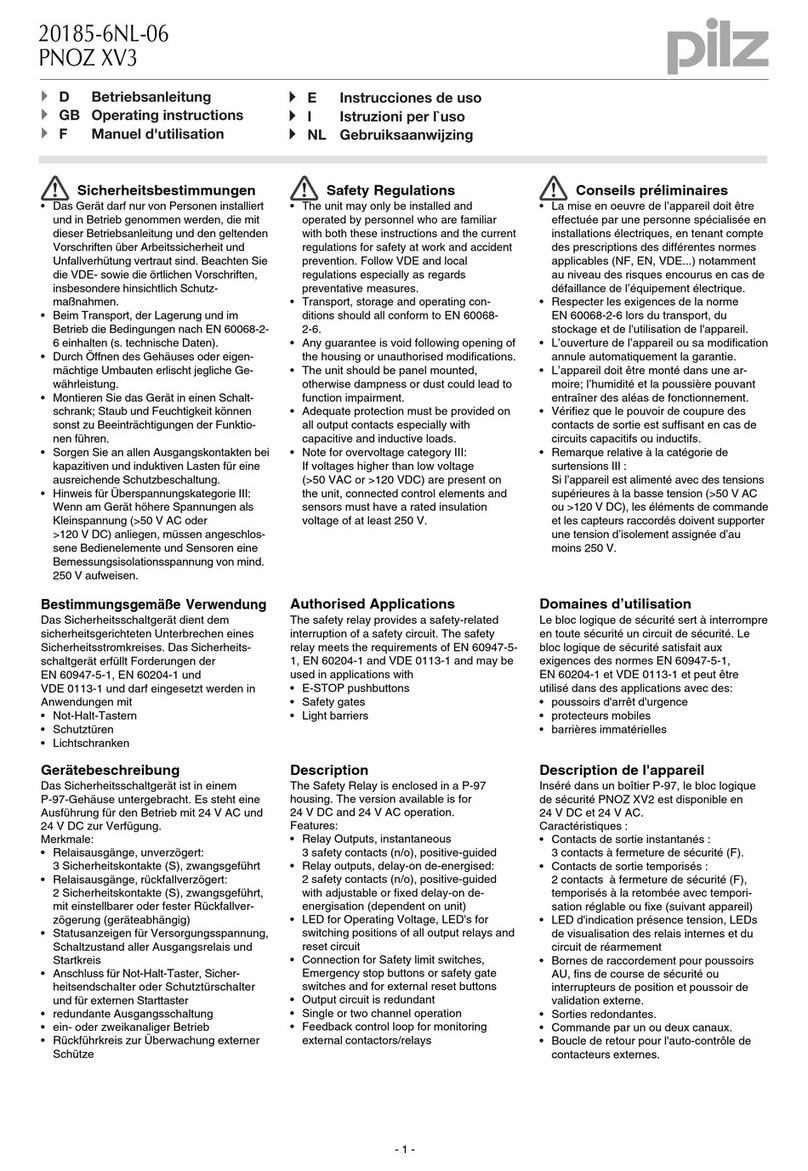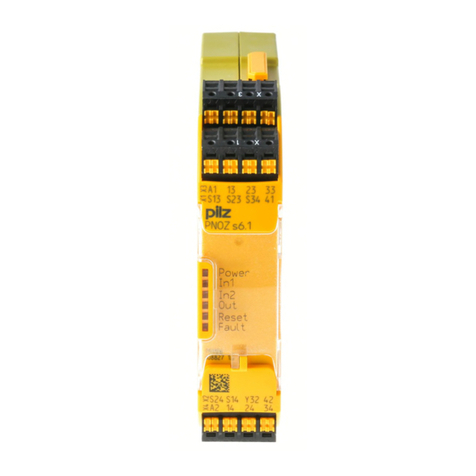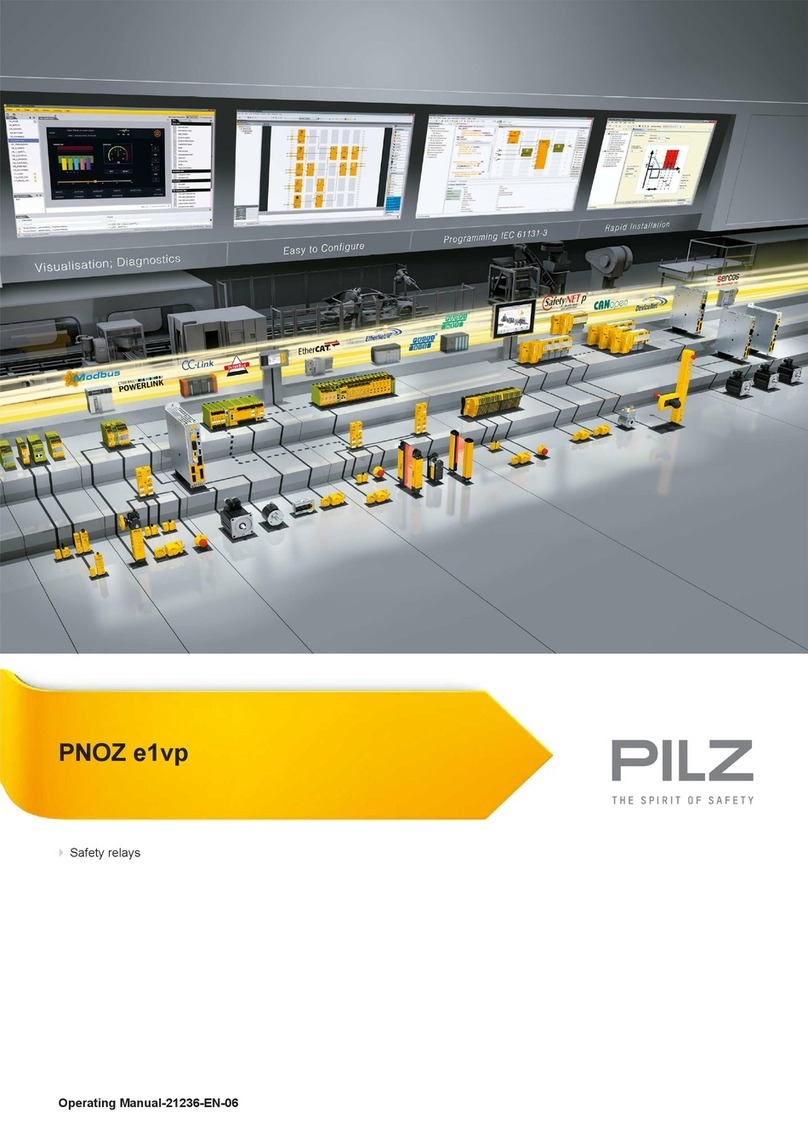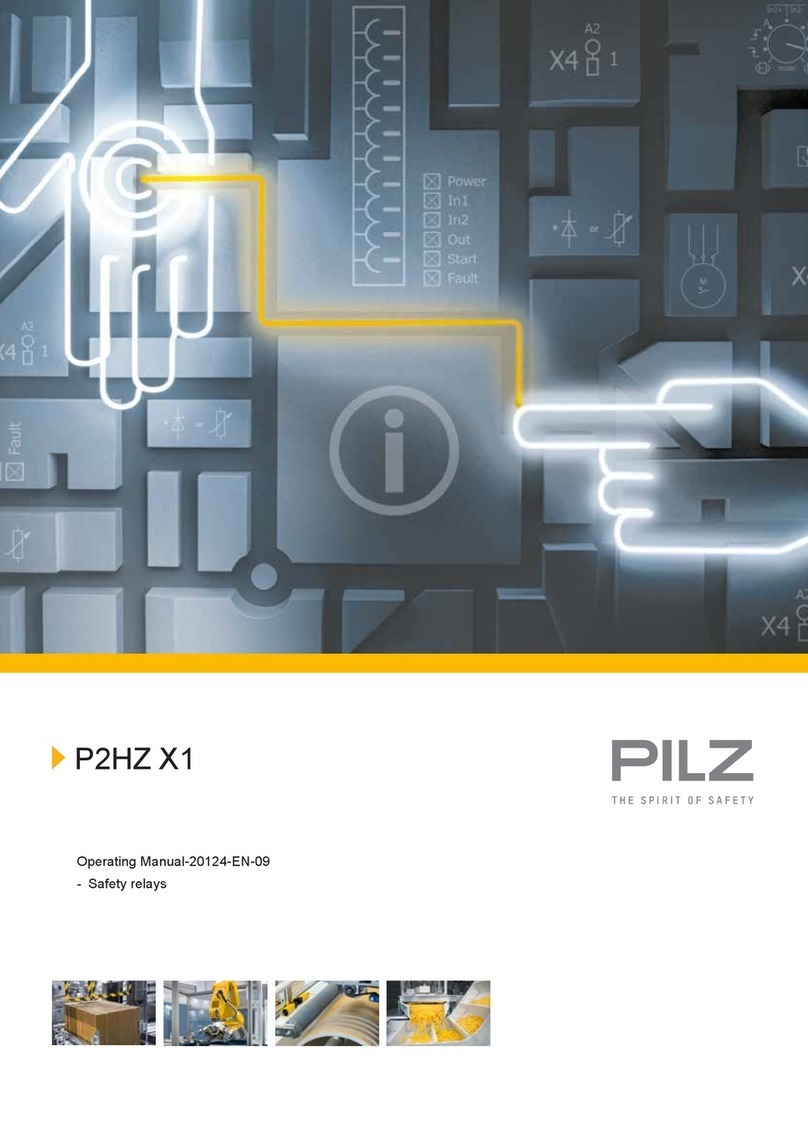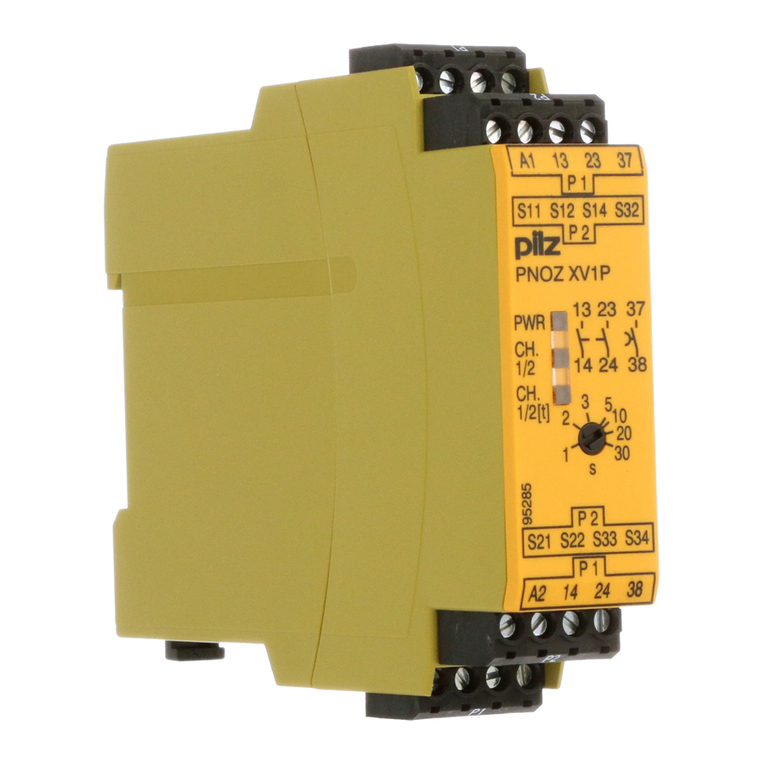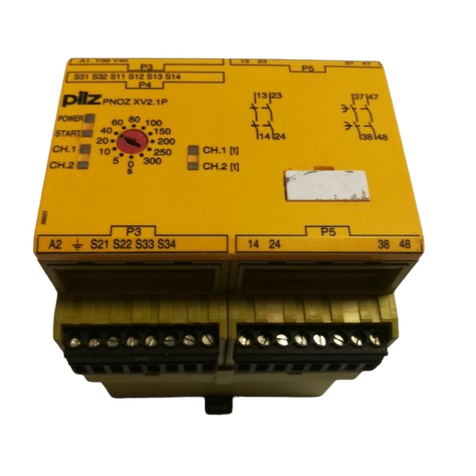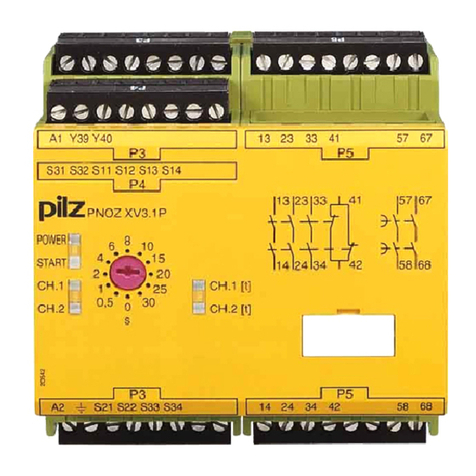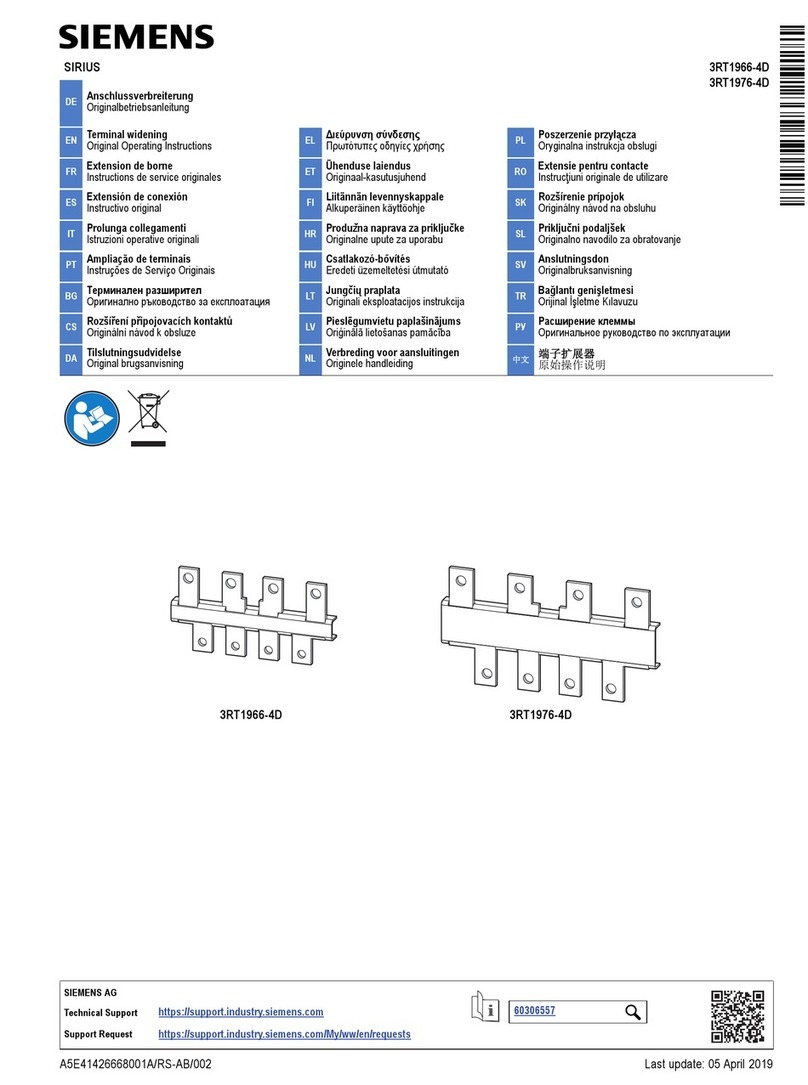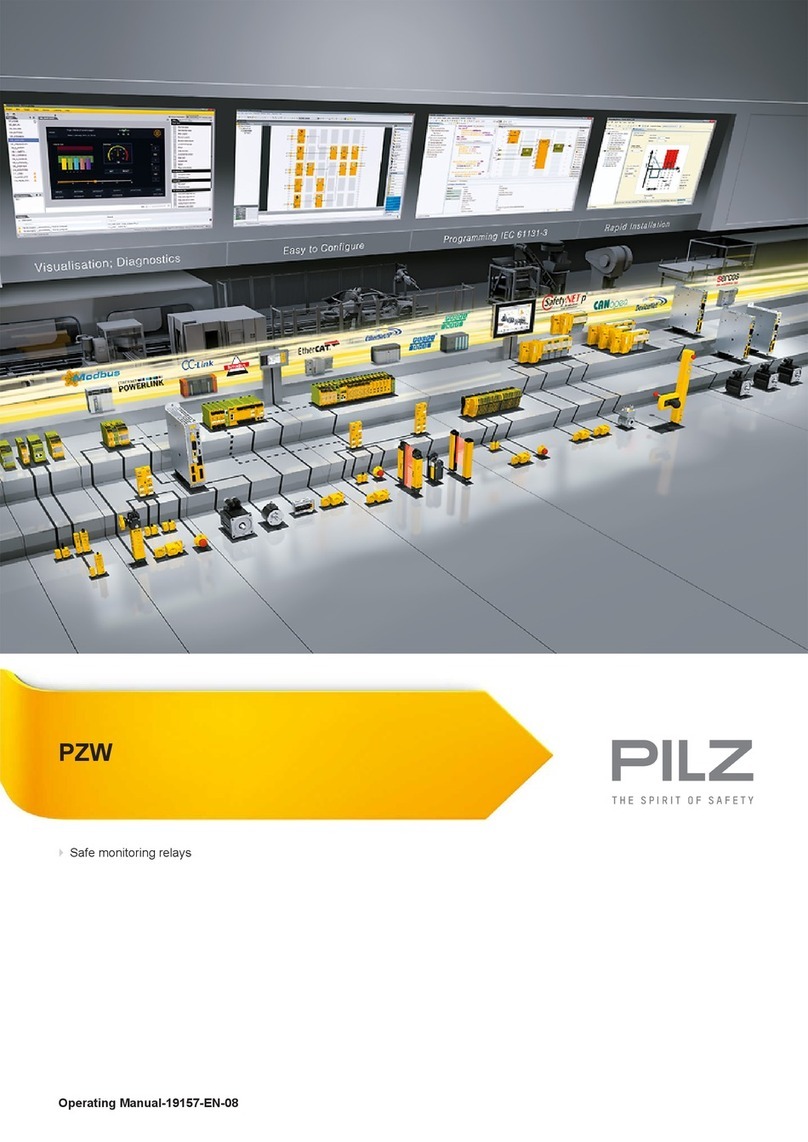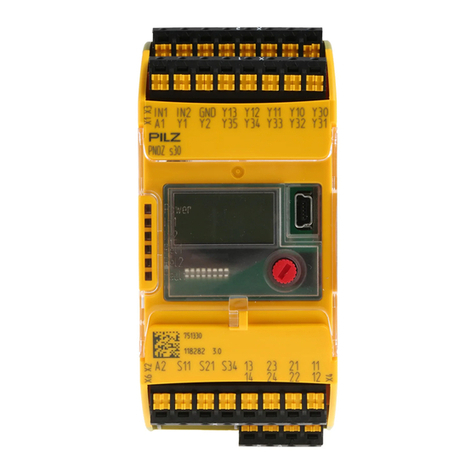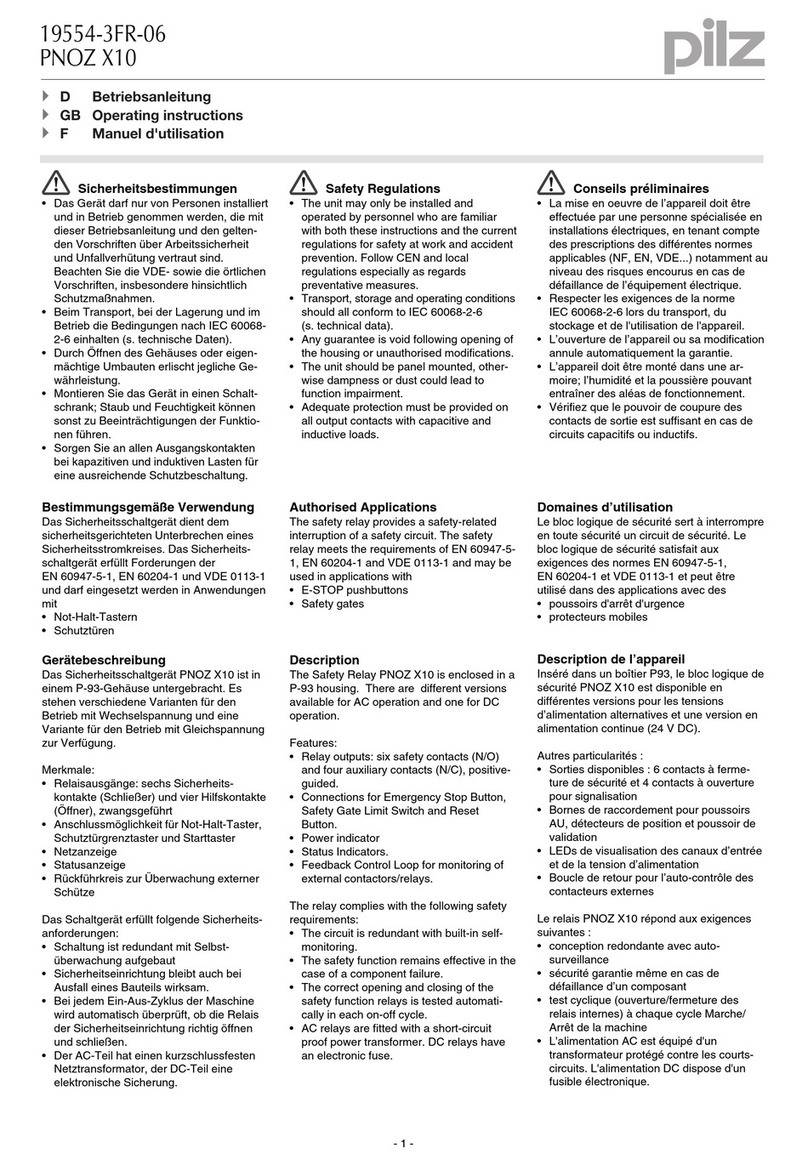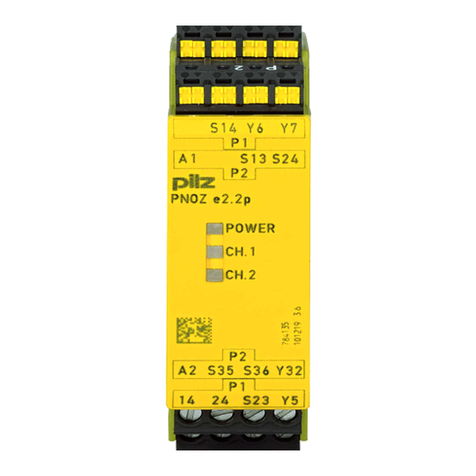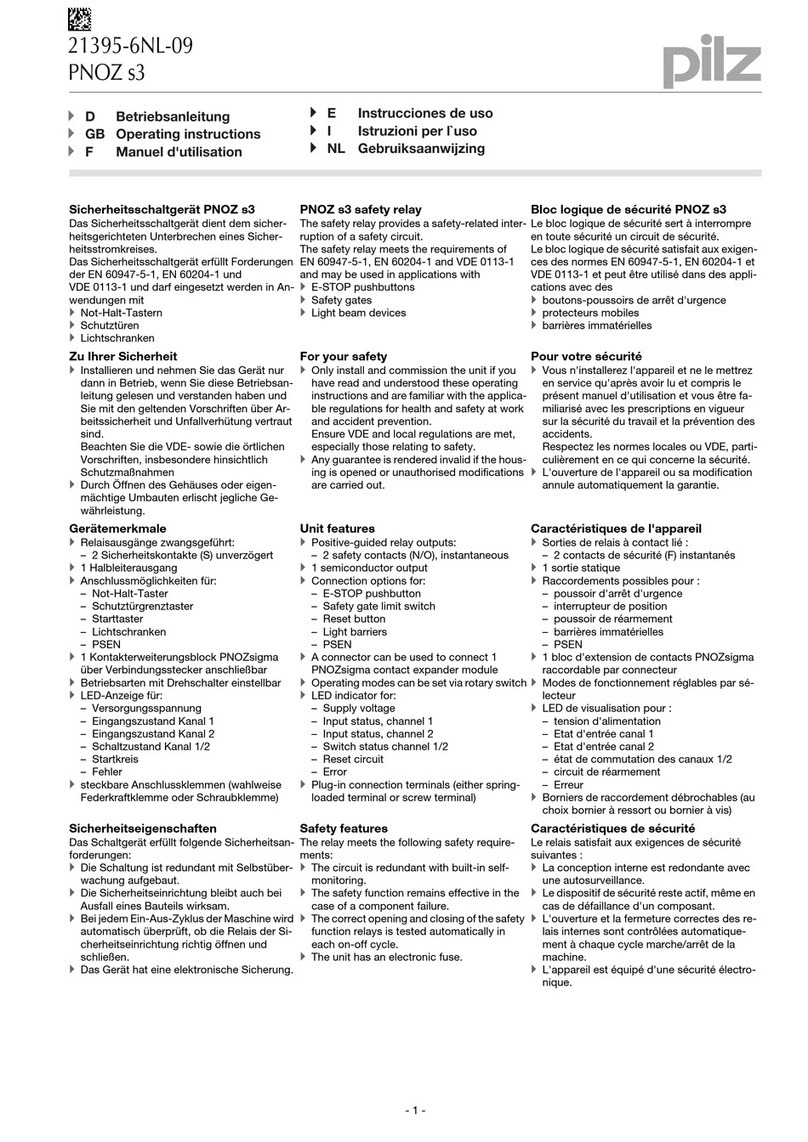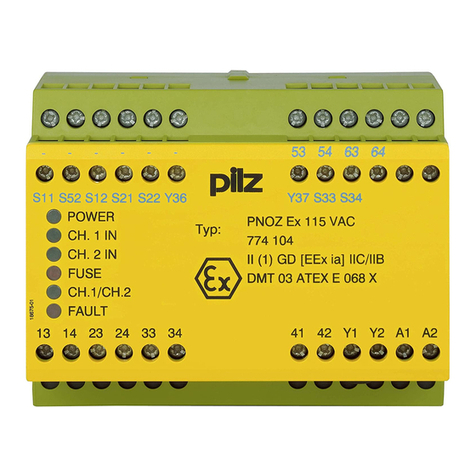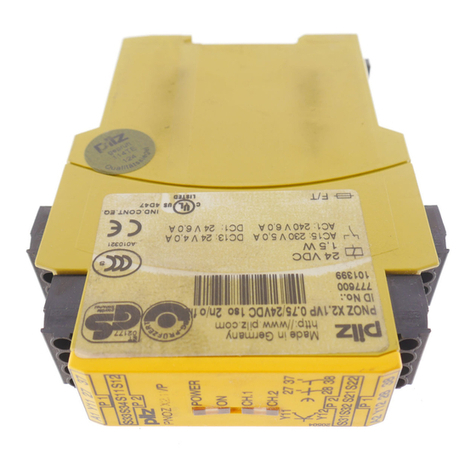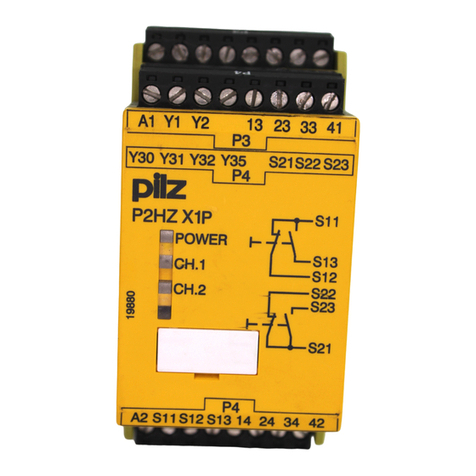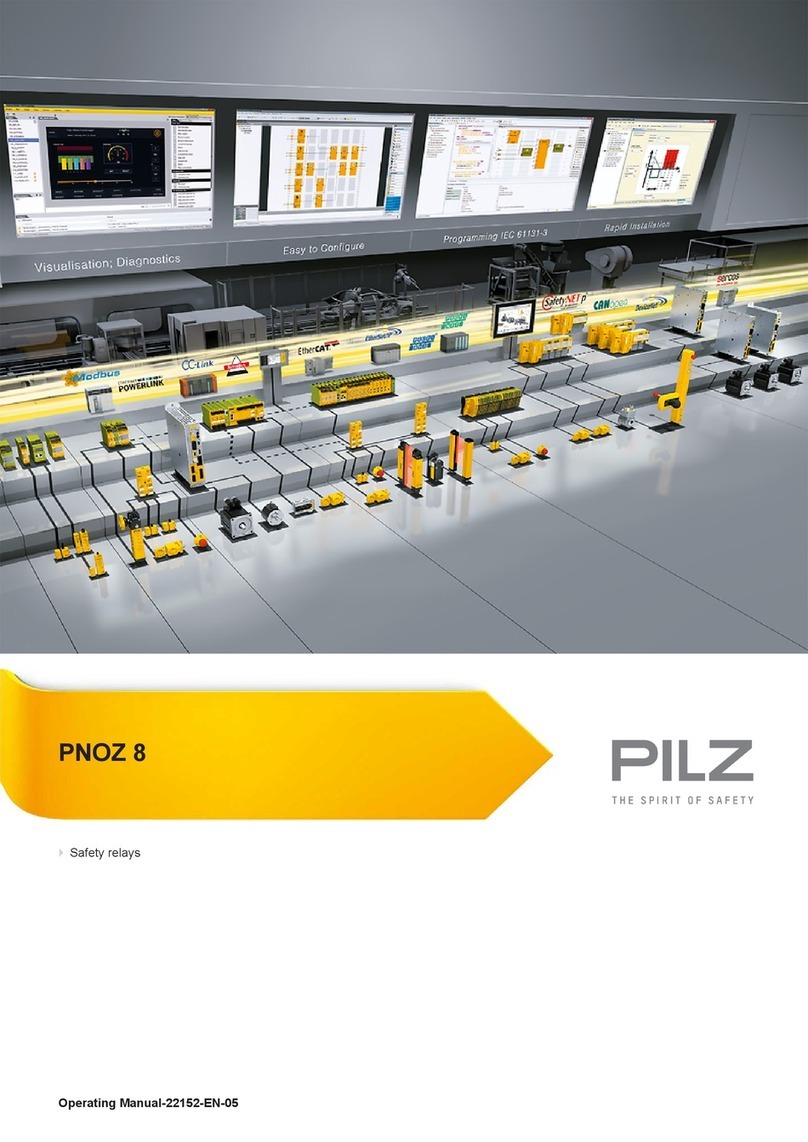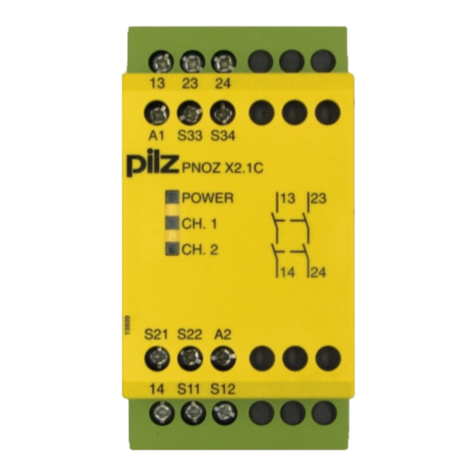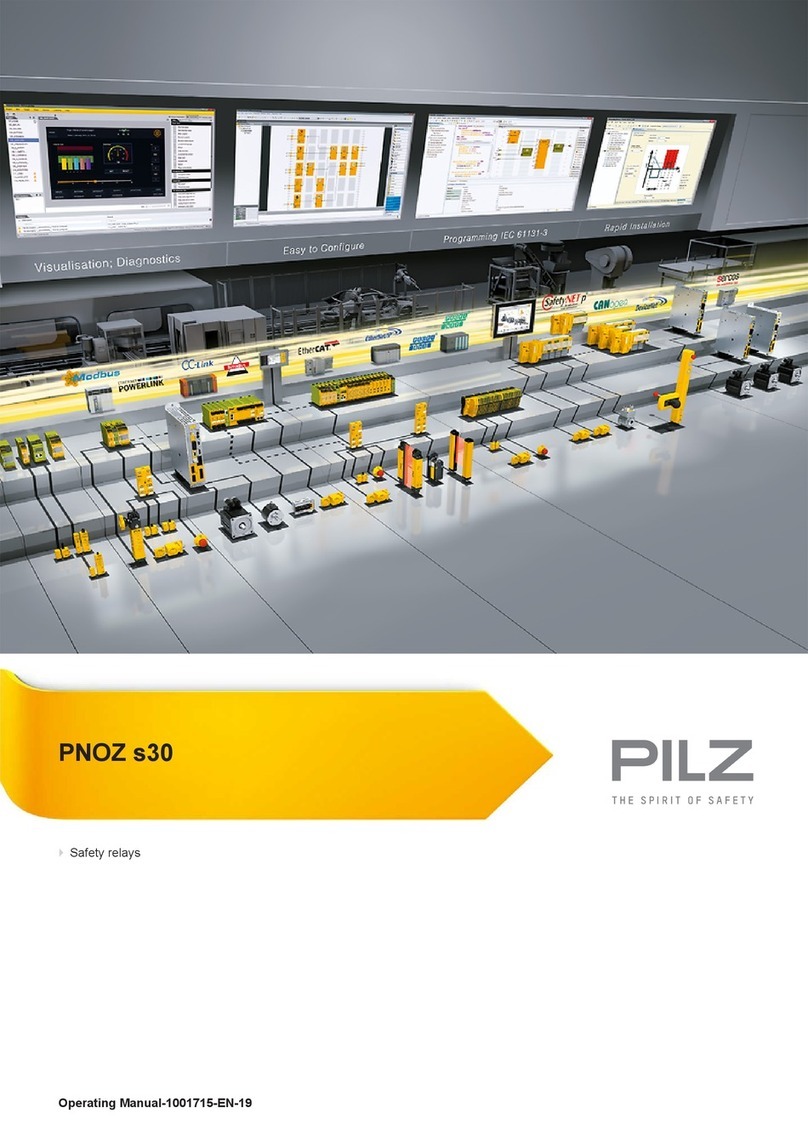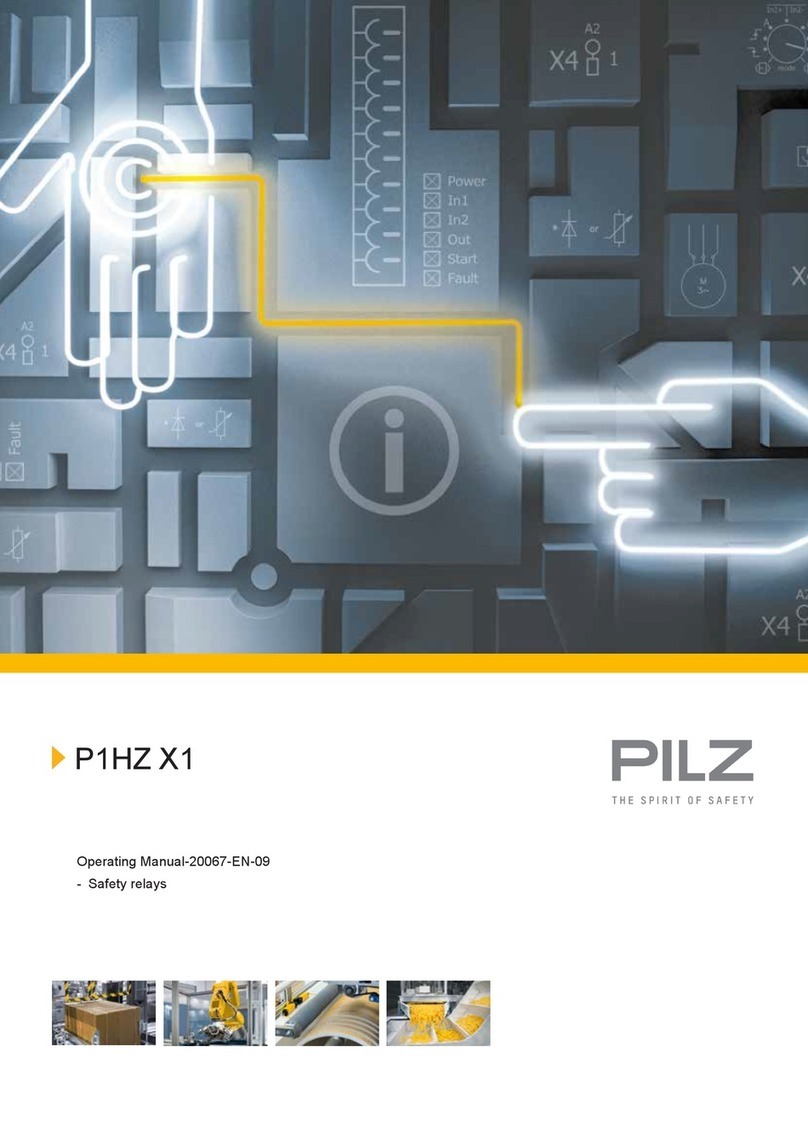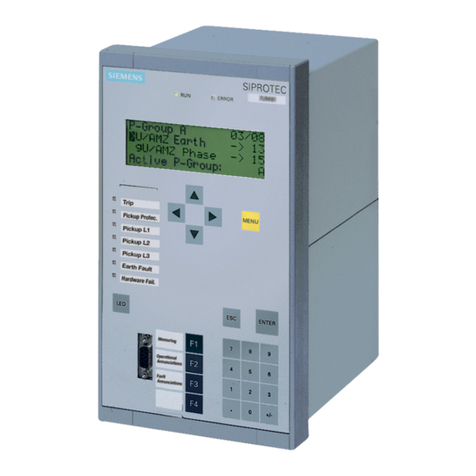
- 3 -
Betriebsarten:
• Zweikanaliger Betrieb: Redundanter
Eingangskreis, Erdschlüsse im Taster-
kreis und Querschlüsse zwischen den
Tasterkontakten werden erkannt.
• Manueller Start: Gerät ist erst dann aktiv,
wenn ein Starttaster (im eigen- oder nicht
eigensicheren Bereich) betätigt wird.
Dadurch ist ein automatischer Start des
Schaltgeräts nach Spannungsausfall und
-wiederkehr ausgeschlossen.
• Manueller Start mit Überwachung: Gerät
ist erst aktiv, wenn der Starttaster
betätigt und wieder losgelassen wurde.
• Kontaktvervielfachung und -verstärkung
durch Anschluss von externen Schüt-
zen.
u.v.a.
Montage
Das Sicherheitsschaltgerät muss in einen
Schaltschrank mit einer Schutzart von
mind. IP54 eingebaut werden. Zur
Befestigung auf einer Normschiene hat
das Gerät ein Rastelement auf der
Rückseite.
ACHTUNG!
• Gerät immer außerhalb des explosions-
gefährdeten Bereichs montieren.
• Luftstrecken zwischen blanken Teilen
eigensicherer Stromkreise und geerde-
ten Metallteilen müssen mind. 3 mm
betragen, Luftstrecken zwischen
blanken Teilen eigensicherer Stromkrei-
se und blanken Teilen nicht eigen-
sicherer Stromkreise müssen mind. den
in Tabelle 2, Änderung 4 von EN 50020
geforderten Werten entsprechen.
Inbetriebnahme
Beachten Sie bei der Inbetriebnahme:
• Der Ex-Schutz wird nur erreicht, wenn
alle Bedienelemente, die an den nicht
eigensicheren Bereich (s. Fig. 1) ange-
schlossen sind, in einem Ex-geschütz-
ten Raum montiert werden. Für die
Anschlusselemente des eigensicheren
Bereichs ist kein Ex-Schutz notwendig.
• Nur die Ausgangskontakte 13-14/23-24/
33-34 sind Sicherheitskontakte.
Ausgangskontakte 41-42/53-54/63-64
sind Hilfskontakte (z. B. für Anzeige).
•Vor die Ausgangskontakte eine
Sicherung (s. technische Daten)
schalten, um das Verschweißen der
Kontakte zu verhindern.
• Berechnung der max. Leitungslänge Imax
(Eingangskreis):
R
lmax
R
l
/ km
I
max
=
Rlmax = max. Gesamtleitungswiderstand
(Eingangskreis)
Rl/km = Leitungswiderstand/km
• Nur geschirmte Leitungen verwenden.
• Anschlussteile für äußere eigensichere
Stromkreise: zwischen blanken Teilen
des eigensicheren Stromkreises und
blanken Teilen des nicht eigensicheren
Stromkreises mind. 50 mm Abstand
einhalten oder durch eine Trennwand
nach EN 50020 Abs. 5.4.1 trennen.
Operating Modes
• Two-channel operation: redundant input
circuit, short-circuits in the emergency stop
circuit and shorts across the emergency
stop button contacts will be detected.
• Manual reset: Unit is only active, when a
reset button has been pressed ( in the
intrinsically or non-intrinsically safe area).
Automatic reset following a loss/return of
supply voltage is thereby prevented.
• Monitored manual reset: Unit is only active
when a reset button has been pressed and
released again.
• Increase in the number of available
contacts by connecting external
contactors/relays.
And many more.
Installation
The safety relay must be panel mounted to at
least IP54. There is a notch on the rear of the
unit for DIN-Rail attachment.
WARNING!
• The unit must always be mounted outside
the potentially explosive area
• Airgap creepage between the uninsulated
part of the intrinsically safe safety circuit
and the earthed metal parts must be at
least 3 mm. Airap creepage between the
uninsulated parts of the intrinsically safe
safety circuit and the uninsulated parts of
the non-intrinsically safe safety circuit must
conform to the required values in Table 2,
Amendment 4 of EN 50020.
Operation
Please note for operation:
• Ex-protection can only be achieved if all
operating elements connected to the non-
intrinsically safe area are installed in an Ex-
protected room. For the connection
elements of the intrinsically safe areas, Ex-
proection is not necessary.
• Only the output contacts 13-14/23-24/33-
34 are safety contacts. Output contact 41-
42/53-54/63-64 are auxiliary contacts (e.g.
for status).
•To prevent single contact welding, a
fuse (see technical details) must be
connected before the output contacts.
• Calculate the max. Cable runs Imax (Input
circuit)
R
lmax
R
l
/ km
I
max
=
Rlmax = Max. Total cable resistance (Input
circuit)
Rl/km = Cable resistance/km
• Only use screened cables.
• Connection parts for outside the
intrinsically safe area: there must be a
distance of at least 50 mm between
uninsulated parts of the intrinsically safe
safety circuit and the uninsulated parts of
the non-intrinsically safe or a safe
separtion or separted by a partition which
conforms to EN 50020 Pt. 5.4.1.
Modes de fonctionnement :
• commande par 2 canaux : circuit
d’entrée redondant. La mise à la terre du
circuit d’entrée ainsi que les courts-
circuits entre les canaux sont détectés.
• Réarmement manuel : le relais n’est
activé qu’après une impulsion sur le
poussoir de réarmement. Un réarmement
automatique du relais après une coupure
d’alimentation est ainsi impossible.
• Réarmement manuel auto-contrôlé : le
relais n’est activé qu’après une action et
un relâchement sur le poussoir de
réarmement.
• Augmentation du nombre de contacts ou
du pouvoir de coupure par l’utilisation de
contacteurs externes.
Et plus encore.
Montage
Le relais doit être monté dans une armoire
électrique ayant un indice de protection IP54
au minimum. Sa face arrière permet un
montage rapide sur rail DIN.
ATTENTION !
• L’appareil doit toujours être monté en
dehors de la zone explosive.
• Le cheminement entre les éléments nus
du circuit de commande de la zone
intrinséque et les parties métalliques
reliées à la terre doit être d’au mini. 3 mm.
Le cheminement entre les éléments nus
du circuit de commande de la zone
intrinséque et ceux de la zone normale
doit répondre aux exigences du tableau
2, modification 4, de la norme EN 50020.
Mise en oeuvre
Remarques préliminaires :
• La protection Ex n’est obtenue que si les
élements de commande raccordés à la
partie non intrinséque du relais (voir fig.
1)
sont montés dans un boîtier Ex. Pour les
éléments raccordés à la partie
intrinséque
du relais, aucune protection Ex n’est
nécessaire.
• Seuls les contacts 13-14/23-24/33-34
sont des contacts de sécurité. Les
contacts 41-42/53-54/63-64 sont des
contacts d’information.
• Protection des contacts de sortie par
des fusibles (voir les caractéristiques
techniques) pour éviter leur soudage.
• Calculer les longueurs de câblage max
Imax (Circuits d’entrée):
R
lmax
R
l
/ km
I
max
=
Rlmax = résistivité de câblage totale max.
(Circuits d’entrée)
Rl/km = résistivité de câblage/km
• N’utilisez que des conducteurs blindés.
• Raccordement des éléments de la zone
intrinséque : les éléments nus du circuit
de commande de la zone intrinséque et
ceux de la zone normale doivent être
distants d’au mini. 50 mm ou séparés par
un panneau de séparation selon la norme
EN 50020, § 5.4.1.
* Isolation zum nicht markierten Bereich und der
Relaiskontakte zueinander: Basisisolierung
(Überspannungskategorie III), sichere
Trennung (Überspannungskategorie II)
* Insulation between the non-marked area
and the relay contacts: Basic insulation
(overvoltage category III), safe separation
(overvoltage category II)
* Isolation de la partie non sélectionnée par
rapport aux contacts relais : isolation
basique (catégorie de surtensions III),
isolation galvanique (catégorie de
surtensions II)
